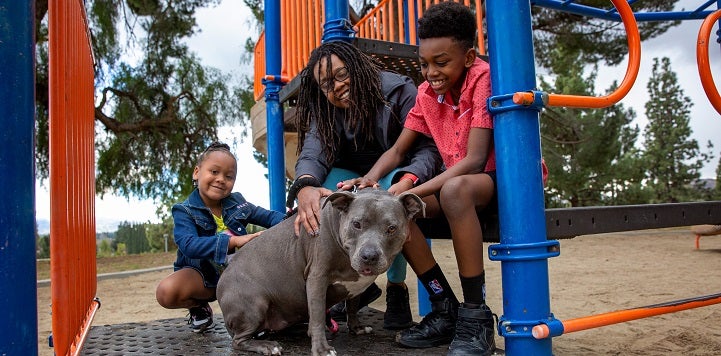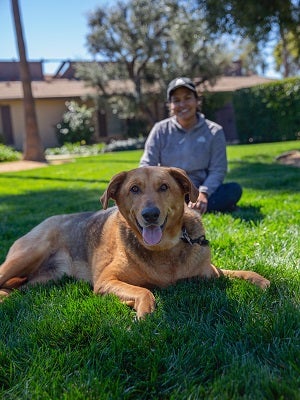
Rescue Roadblock Pledge Participants Share Their Successes
Last fall, we challenged our Network partners to become roadblock-free. By getting rid of intrusive application processes and a plethora of requirements for every dog or cat going into a new home, our industry will be better positioned to reach our shared goals of reducing the number of pets in shelters, increasing the number of animal-friendly communities, and providing more resources to keep pets in their homes in the first place.
So, we asked you to sign up and take the pledge to cut the red tape out of your adoption processes and expand your ability to help more animals—and a little more than 100 partners did just that! Now that groups have had six months with fewer restrictive practices in place, they were happy to share their insights with those who weren’t quite ready to take the plunge last August (but might be willing to do so after reading this!).
Adjusting the Application Process
The adoption process was the most frequent target of change. Many whittled lengthy applications down to more manageable sizes, cutting out questions about what the adopter would feed their pet or how many hours per day a pet might be left alone. Home checks and required references also went by the wayside.
In place of those roadblocks? A shift to a conversation-based approach with potential adopters that focuses on “the relationship between the adopter and the new pet,” according to executive director Leah Craig Fieser, executive director of Brother Wolf Animal Rescue in Asheville, North Carolina.

“We spend time talking to adopters about what animal would make the best match with their household,” she says. “We believe that if someone has the intention of adopting an animal, they are wanting to do a good thing and that we're here to support them, and the animals, in that process. As a result, our adopters also feel confident reaching back out to us if they ever need support.”
Several groups, including Heartland Humane Society in Corvallis, Oregon, eliminated the rule that all family members must attend adoptions.
“We are letting adults make the best decision for their family,” says director Kerry Feilmeier. “We also let families decide if they want to bring their resident dog to meet the potential new dog, although we still highly encourage bringing them.”
Others began allowing for foster-to-adopt arrangements and found them to be very successful.
“Sometimes people avoid adopting in the first place because they are afraid they’ll have to return an animal,” says Deborah Felin-Magaldi, co-founder and director of Helen Sanders Cat Protection and Welfare Society (PAWS) in Seal Beach, California. “This option reduces such anxiety, and we rarely have such people not adopt their foster cat.”
Though unrelated to adoptions, the practice of requiring appointments for owners to surrender their pets—which the pandemic made commonplace for many shelters—has resulted in fewer animals ever needing to be sheltered at all.
“COVID was a negative that turned into a positive because more fosters came forward to take in relinquished pets directly,” according to Amber Dennison, board member for the Humane Society of the Ohio Valley. “Some people even rehomed their pet while waiting for their appointment.”
Letting Go of Limitations
When we have specific information about an individual animal—say a dog has clearly demonstrated that he is no fan of small children—then setting requirements that eliminate homes with small kids makes sense. Too often, however, such requirements are applied arbitrarily and end up eliminating appropriate homes.
“We had a situation recently where a dog adopted to a family that lived in an apartment was returned because he barked at every noise he heard,” says Martha Wittkowski, executive director of Des Moines-based Animal Lifeline of Iowa. “Though the staff immediately wanted to add to his profile that he could not live in a shared wall space, instead we told adopters what happened and focused on his need for an active home.
“Honest and truthful information normally results in potential adopters making the right choice, and we are slowly removing phrases such as ‘must have a fenced-in yard’ or “must be the only pet’ from our vocabulary.”
Memphis Animal Services director Alexis Pugh recognized that breed labels can be a big roadblock to many dogs even being considered by adopters and took them off the kennel cards.
“By doing so, we were also able to remove this arbitrary rule we used to have that any pit bull adopter must have a fenced yard,” she says. “And because we know many dogs with these physical characteristics do great in apartments, we’re no longer needlessly counting out apartment dwellers, which is a very large demographic.”

Making Fees Flexible
Discounted or even waived fees are a particular bone of contention for animal welfare staff and volunteers, but organizations are increasingly letting go of the misconception that people who get animals for free don’t value them. Instead, many organizations are seeing that flexibility on adoption fees not only increases adoptions, but it also increases possibilities for special needs animals to be placed into homes.
Helen Sanders PAWS, which always offers two-for-one adoptions, notes that waiving adoption fees has helped the organization place older cats and those with medical issues. Animal Lifeline of Iowa also eliminated adoption fees on FIV and/or FeLV cats to encourage adopters to consider them as a potential companion.
Other organizations, like the Humane Society of Southwest Missouri, offer value-added adoptions by providing free training for dogs with behavior challenges or medication for animals with chronic medical issues. And in Memphis, special-needs pets are no longer available strictly to rescue groups.
“We have now made them available for public adoption,” Alexis says. “Thanks to additional grant and donor support, we were also able to assist with heartworm treatment for adopters, opening up an avenue to more of those dogs getting into homes.”
Overcoming the Objectors
Of course, lifting roadblocks was not without challenges for the organizations that took the pledge.
“We shared the roadblock-free approach with our rescue partners, and most were unwilling to consider dropping home checks, references, etc. People are comfortable doing things the way they’ve always been done,” Alexis says. “Yet, as much as we all wish there were a test to tell you if someone is a good person and will make a good pet parent, there isn’t. We had to show people that roadblocks and obstacles simply don’t work to prevent bad adoptions, but we do know that eliminating them works to save more lives.”
In the case of the Humane Society of Southwest Missouri, the organization had to convince its vet to support adopting animals with medical issues to the public.
“We engaged in dialogue to help her understand that private care can be better because we already have a limited budget and huge volume to care for,” says executive director Sue Davis. “With her help, we developed a process to screen medical adopters to ensure they have proper knowledge and resources to care for a medical case.”
Alexis notes that organizations can always look to national proven practices to guide messaging, and the Eau Claire County Humane Association (ECCHA) relied heavily on webinars and HSUS’s Adopters Welcome guide to educate its staff.
“It helped them see how change would benefit our pets in the long run,” says ECCHA operations director Karen Rabideaux.
Reviewing the Lessons Learned
An obvious benefit to the animals cared for by organizations who took the pledge is a reduction in their length of stay (LOS). Heartland Humane Society saw its LOS dip from 30.2 days in April 2020 to 27.3 days in January 2021, while Midland, Texas-based Fix West Texas saw most of its cats going into adoptive homes within two to three days.
At Animal Lifeline of Iowa, adopters no longer need to wait 24 to 48 hours for their applications to be reviewed. Today, Martha says, “we do most of them the same day and the animal is adopted the same day. We have received compliments on how nice our new process is.”
For The Love Pit Dog Rescue in Dallas, some of the positive impacts of removing roadblocks are the ripple effects they have had on unexpected areas of the organization.
“Changes in the standard operating procedures from one team are leading to changes in other departments,” says Malory Skaugen, managing director of innovative programs and advocacy. “Directors are seeing the bigger picture, refining processes to make things easier and more efficient, and are able to spend their energy on collaborating with each other to make the whole organization stronger.”
And as more organizations have positive experiences with moving away from “the way it’s always been done,” they are becoming evangelists for change.
“Doing away with roadblocks is a topic that many treat as taboo, but the more we speak up about the success, the more people will embrace it,” says Karen Patterson, Fix West Texas’s board president and vice president of operations.
That was our hope when we put out the challenge to organizations, some of whom noted that seeing the large, national animal welfare organizations making such changes helps dispel the concept that shelters and rescues are “going rogue.”
“Brother Wolf is thrilled that Best Friends is encouraging other rescue groups and shelters to do away with roadblocks to adoption,” Leah says. “We all want to see a day where every adoptable animal finds a home, and this is an important step in reaching that collective goal."
Bethany Heins
Director of strategy and network operations
Best Friends Animal Society
If you enjoyed this program spotlight, you can find our complete catalog of spotlights here.